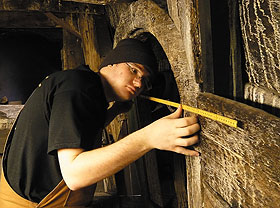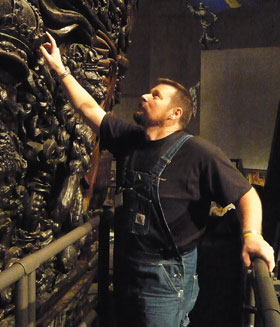  |
| HOME | THIS ISSUE | CALENDAR | PATENTS | BACK ISSUES | < BACK | NEXT > |
Undergraduates spend break studying 17th-century shipwreck by Cindy Weiss - February 11, 2008 | ||||||
| Six students in the College of Liberal Arts and Sciences can be counted among the elite of shipwreck archaeology, after spending the winter intersession in an unusual new Study Abroad program. They were the first undergraduates ever allowed to work on the ‘Cadillac’ of shipwrecks, the nearly intact 1628 wreck of the warship Vasa in Stockholm, Sweden
The Vasa, which was raised from Stockholm Harbor 47 years ago and has its own museum built around it, is the only intact recovered 17th-century shipwreck in the world. Its recovery was one of three pioneering projects that started the discipline of maritime archaeology. Conservation techniques developed for it set the standards for years to come. The elaborate warship, covered with more than 500 iconographic wood carvings and once-gilded sculptures, was the royal flagship of Swedish King Gustav II Adolf’s bid for maritime supremacy. It never made it out of the harbor, though, sinking on its maiden voyage on Aug. 10, 1628. Researchers from the Vasa Museum, part of the Swedish National Maritime Museums, are now documenting and analyzing the find. Their results, including the students’ efforts, will be published in a five-volume book series on the wreck and its artifacts. The students were led by David Robinson, a Ph.D. candidate in anthropology who teaches at Avery Point in the College of Liberal Arts and Sciences’ new maritime archaeology minor. Robinson’s former professor in the nautical archaeology master’s degree program at Texas A&M University, Fred Hocker, is now director of research at the Vasa Museum. Robinson and Hocker designed the program that allowed UConn undergraduates to participate in the Vasa study as a Study Abroad opportunity. The program was so successful that the Vasa Museum has invited UConn back and plans to expand its collaboration to other universities, Robinson says. The UConn students faced the challenge of documenting the massive, 200-foot-long ship in just three weeks. They concentrated their work on the 4.5-story stern. “It was a little bit overwhelming at first,” says Julia Lysaght, a senior majoring in anthropology. “It was a magnificently beautiful ship. Pictures do not do it justice,” she says. “It opened a new wing of my interest.” She now plans to work in maritime archaeology, with a focus on the conservation of artifacts.
The Vasa was built as the most heavily armed ship in the Baltic Sea – “the flagship of the king’s fleet and an extraordinary conveyor of the power of the Swedish empire,” says Robinson. The wreck was well preserved because the shipworm, Teredo navalis, a wormlike mollusk that bores into wood, is not present in the Baltic due to its high freshwater content. Part of the ship also sank in mud, and the anaerobic environment preserved details and even paint on many of its sculptures. The ship was built without a blueprint, a common practice at the time. The UConn students took measurements with Total Station, similar to a surveyor’s transit, and recorded more than 1,200 data points that will be used in creating a plan of the ship. The Vasa museum is a major tourist attraction in Scandinavia, but visitors are restricted to balconies surrounding it in a seven-story hall. The students worked on the ship itself, however, where only museum employees and the king of Sweden are allowed. “Every single day we got to walk on this structure,” says Kaitlin Guardino, a senior majoring in physiology and neurobiology and sociology, who went on the trip. “We researched the broad geometry of it.” The experience of working on the ship was “pretty unforgettable,” says Eric Heffter, a senior majoring in anthropology with a minor in maritime archaeology. “In three weeks, we really learned a lot.” Adds Arthur Williams, “We were told that we’d be ‘shipwreck snobs’ now.” Williams is a senior at the Avery Point campus who is majoring in maritime studies with a minor in marine archaeology. Experiences like the Vasa program are the new face of Study Abroad, says Ross Lewin, director of UConn’s Study Abroad program. Special programs such as the Vasa research and planned programs to study contemporary art in India, pharmacy in China, and social entrepreneurship in Guatemala let students focus on what it means to be a global citizen, he says. “We’re really trying to get out in the lead on this at UConn.” |
| ADVANCE HOME UCONN HOME |


